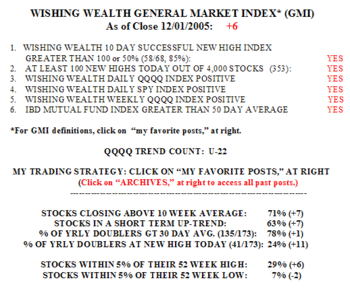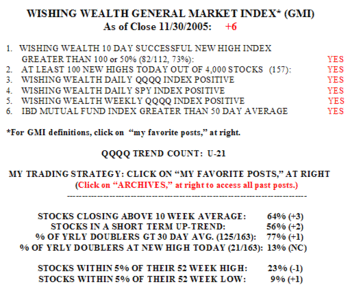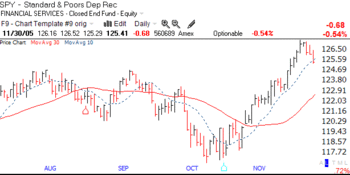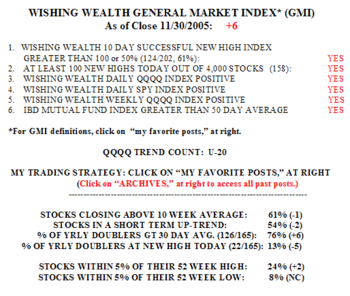What an incredible day Thursday! The GMI remains at the maximum +6, and many of my indicators are at new peaks.  There were 353 new yearly highs in my universe of 4,000 stocks. 85% of the 68 stocks that hit a new high ten days ago closed higher on Thursday than they closed ten days earlier. 63% of stocks are in a short term up-trend and 71% closed above their 10 week averages. 95% of the Nasdaq 100 stocks advanced, along with 89% of the S&P 500 stocks and 87% of the Dow 30 stocks. 78% of the stocks that doubled in the past year closed above their 30 day averages and 24% hit a new high today. Four times as many stocks are within 5% of their yearly highs than their yearly lows (29% vs. 7%). Thursday was the 22nd day of the QQQQ up-trend (U-22). Clearly, this is a market in a strong up-trend.
There were 353 new yearly highs in my universe of 4,000 stocks. 85% of the 68 stocks that hit a new high ten days ago closed higher on Thursday than they closed ten days earlier. 63% of stocks are in a short term up-trend and 71% closed above their 10 week averages. 95% of the Nasdaq 100 stocks advanced, along with 89% of the S&P 500 stocks and 87% of the Dow 30 stocks. 78% of the stocks that doubled in the past year closed above their 30 day averages and 24% hit a new high today. Four times as many stocks are within 5% of their yearly highs than their yearly lows (29% vs. 7%). Thursday was the 22nd day of the QQQQ up-trend (U-22). Clearly, this is a market in a strong up-trend.
The following stocks that hit a new high Thursday, had earnings increases last quarter of at least 100% and have at least doubled in the past year: TIE, MIND, PLLL, LMS, CUTR, TRID, CRM, AAPL, HANS, DRQ, VPI, DBRN, HOLX, RES and BBBB. I have listed many of these leading stocks in my prior posts and I own a couple of them. This list of winners is worthy of further consideration and research.
Since November 1, the SPY has increased 5.15%. According to an industry scan I ran on TC2005, during this period the top performing industries have been: Internet service providers (+21.8%), Semiconductor-integrated circuits (+19.7%), Silver (+19.6%), Computer based systems (+18.2%), Copper (17.9%) Semiconductor equipment (+17.7%) and Aluminum (+17.6%).
NOTE: A NEW SECTION TO THE BOTTOM RIGHT PROVIDES LINKS TO MY FAVORITE PRIOR POSTS. THESE INCLUDE MY STRATEGY POSTS, DEFINITIONS OF THE GMI COMPONENTS, AND MY ANALYSIS OF WHY THE TRADING TECHNIQUES OF THE GREAT NICOLAS DARVAS WORK BEST DURING BULL MARKETS AT ALL-TIME HIGHS.
How have you used this site to inform your trading? Can you send me some experiences I can post for others (anonymously, with your prior permission)? Please send your pearls of Wishdom to me at: silentknight@wishingwealthblog.com.


